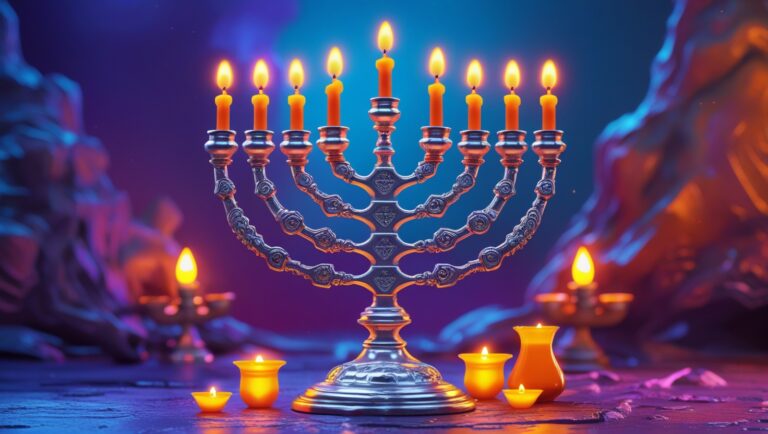Kabbalah has many systems of probing the secrets of Creation, two of which are the Hebrew Nekudot (punctuation marks) and the Aleph Bet.
Rabbi Yosef Gikatila was a renowned Spanish Mekubal that came before the Arizal. He’s most known for his great Shaarei Orah which discusses the nature of the 11 Sephirot and the God’s divine names associated with them. Yet, a less known work of his is his Sefer HaNikud (the book of punctuation), which discusses some of the Kabbalistic secrets regarding the 9 punctuation (vowel) marks which appear in the Aleph Bet.
As one might have guessed, the 9 punctuation marks correspond each to one Sephira and we find the following division in Otzrot Chaim:
- Kamatz – Keter
- Patach – Chokhmah
- Tzere – Binah
- Segol – Chessed
- Shvah – Gevurah
- Cholam – Tiferet
- Chirik – Netzach
- Kubutz – Hod
- Shuruk Milupam – Yesod
- No Nikud – Malkhut (because it “has nothing of its own”)
R’ Yosef Gikatilla begins his Sefer HaNikud as follows:
Know, my dear friend, that although we have informed you of the many virtues regarding the Sefirot and the Chariots, we must inform you that just as the body moves by a moving force, whether dead or alive, the dead, like a pen moved by a living hand, and the living, like the human body moved by the vital soul within it, so too the letters of the Torah, which are 22, some of them are called Chashmal letters, and they move the other letters like the soul moves the body.
Some letters are called living creatures, and they also move the other letters, but not like the Chashmal letters. When they move, they move together, and there are two distinct movements in one letter. Some letters are called wheels and do not move themselves unless moved by the Chashmal letters or the living creatures in one of their specific movements.“
This helps us grasp a little better on how Hashem created the world by “speaking”, and that reality is composed of innumerable letters interacting with each other and forming divine names. In fact, as most people know, the entire Torah is composed of many divine names interwoven, and that comprises the “program” running Creation.
This also explains a little better the importance of uttering study and prayer properly so it resonates with the underlying code, and also how the pronunciation of some divine names can affect reality (this last practice is expressly forbidden except for truly holy Tzadikim).
Hashem however is the only source behind everything and can change everything at will.
Let’s understand a little better the secret of the Aleph Bet and the Chashmal
The concept of Chashmal, introduced in the prophetic visions of Ezekiel, occupies a pivotal place in Kabbalistic thought, embodying the dynamic interplay between concealment and revelation. In Rabbi Yosef Gikatilla’s “Book of Nikud,” Chashmal is described as a state of divine energy that oscillates between being hidden and revealed, symbolizing the intricate nature of spiritual realities.
This term is often translated as “electrum” or “glowing amber,” suggesting a radiant, almost electrical force that is both captivating and elusive. Chashmal represents a profound mystery in which divine energy is both present and obscured, challenging the seeker to penetrate its depths to gain true understanding.
Chashmal represents a state of spiritual consciousness that oscillates between concealment and revelation. It symbolizes a divine energy that is both hidden from the mundane perception and simultaneously influential in the spiritual realm.
From Sefer HaNikud:
“We have already informed you in the book called Shaarei Tzedek how all the Torah is woven upon the name YHVH, blessed be He, who created everything and sustains everything, and there is no other. Everything needs Him, and He needs nothing else. We explained to you how all other sacred names and titles of their kinds all depend on the special name, and He is clothed in them according to the matter of His dominion and the indication of His kingship.
Therefore, it is called Tiferet, as we explained, and we added a great explanation in the chariot of Ezekiel regarding this. After you study those places well, and the matters become clear to you, study this place in what we enter to explain, and you will see all the worlds, all the beings, all the languages, all the letters, and all the Nikudot all depend on the special name, which is YHVH.”
Rabbi Yosef Gikatilla elucidates that the letters of the Tetragrammaton (YHVH), which are central to Kabbalah and also exemplify the essence of Chashmal. These letters are movers—they animate and give life to other letters—but they do so in a manner that remains concealed. When God’s divine name is articulated within words, its letters often do not alter the visible structure of the word but imbue it with a hidden, spiritual dynamism. This dual nature of being active yet hidden aligns perfectly with the concept of Chashmal, where divine influences are exerted without overt manifestation, maintaining a balance between revelation and secrecy.
From the book:
“The letters called Chashmal are the four letters of the name, which move and speak because they move the other letters in the Nikud, and they are hidden and separate and not seen. Therefore, they are called Chashmal, meaning hidden and speaking. The letters called Chayot are the letters called Shin-Mem-Yod-Nun-Aleph-Tav-Vav-Kaf-Bet-Lamed-Tet-Kaf. Some grammarians called them Shin-Mem-Lamed-Kaf-Tav-Vav-Yod-Nun-He. These are the letters that move a physical movement but not an intellectual movement because they do not move others unless they also move with them. The letters called Ofanim are the letters called Gimel-Zayin-Ayin-Tzadik-Pe-Resh-Tet-Samekh. These letters do not move others at all. However, they are moved by the Chashmal letters and the Chayot letters.”
The Chashmal letters operate on an intellectual level, moving the other letters and orchestrating the flow of divine energy within the language. This hidden movement is essential for the spiritual efficacy of the Hebrew letters.
R’ Yosef Gikatilla explains that these letters are not like ordinary letters that are fully revealed in speech and writing; instead, they are the silent conductors of spiritual power. This concealment is not a deficiency but a powerful aspect of their function, indicating that the most potent forces in the universe often operate beyond the realm of the visible and the audible. Thus, Chashmal underscores the principle that true spiritual power often lies in what is unseen and unspoken.
This is practical Kabbalah, and we should not play with God’s divine names, but it’s interesting to know how their operate greater appreciate Hashem’s Creation.
Secrets of the Nekudot
In Kabbalah, the Nekudot (vowel points) of the Hebrew alphabet are not mere phonetic tools but deeply symbolic elements that reveal hidden dimensions of spiritual truth. According to Rabbi Yosef Gikatilla in his “Book of Nikud,” these vowel points serve as the lifeblood of the Hebrew letters, animating them and endowing them with the power to manifest different aspects of God. Each Nekud carries its own unique significance and interacts with the letters to create a dynamic interplay of spiritual forces, making the written and spoken word a conduit for divine energy. This is also based on the Zohar.
R’ Yosef Gikatilla explains that the Holam point, represented as a dot above the letter, signifies the highest level of spiritual consciousness. It is akin to the soul of the letter, inspiring and directing it from above. This point is closely associated with the sefirah of Keter, the crown of the divine emanations, symbolizing pure potential and the initial spark of creation. The Holam’s position above the letter underscores its role as a guiding and transcendent force, much like the way spiritual insight guides and elevates human action.
Now, someone reading this might be asking:
Based on the list given at the beginning of the article, isn’t Cholam supposed to be associated Tiferet instead of Keter? I’d venture to answer that “It all depends on which system we are using or through which perspective we are analyzing a concept”. For example, the Zohar gives many different divisions for the festivals according to the Sephirot. In one place Sukkot is qualified Chesed (because of “water”), sometimes it’s Gevurah (because it’s also a time of judgment). The same happens here, especially if we consider a certain flexibility that the Rashash uses, called the “Drush HaDa’at” (which is legit) to interpret the words of the Arizal.
The Shuruk point, depicted as a dot within the letter, represents a more embodied form of divine influence. Positioned in the middle of the letter, it suggests a balance between the heavenly and the earthly, reflecting the sefirah of Tiferet, which harmonizes opposing forces. The Shuruk’s presence within the letter indicates the infusion of divine energy into the material world, making it a bridge between the ethereal realms and our physical reality. This point highlights the concept that spiritual truths must be integrated into the core of our existence to bring about meaningful transformation.
Lastly, the Chirik point, placed beneath the letter, signifies the grounding of spiritual energy into the most tangible aspects of reality. It aligns with the sefirah of Malkhut, the kingdom that channels divine light into the physical world. The Chirik emphasizes the importance of manifestation and the realization of potential in a concrete form. In Chassidic parlance we could say it means “bringing God down to Earth”.
All of this also explains a little how Kameot (Kabbalah amulets) work, for which the Arizal teaches one who writes the must do Teshuva and do Tikkunim for using the names of God. Again, this is also practical Kabbalah and only a genuine Tzadik who is free of sins and has already rectified his Middot (character traits) can do it.
The Aleph Bet: Foundations of Existence
The structure and order of the Hebrew letters are deeply significant in Kabbalah, as seen from Sefer Yetzirah and Sefer HaBahir. Likewise, R’ Yosef Gikatilla points out that the letters are not randomly arranged but follow a divine order that mirrors the creation and structure of the universe.
The first letter, Aleph, symbolizes the beginning of divine emanation, a hidden spark from which creation unfolds. Following Aleph, the sequence of letters each represents a progression of divine attributes and forces, culminating in Tav, the letter that symbolizes completion and the physical manifestation of the spiritual (Malkhut).
Another interesting insight from R’ Yosef Gikatilla is the concept that Hebrew letters serve as vehicles for the divine presence, just like the Nekudot. Yet, they also comprise their own system.
This is particularly evident in the use of letters in holy texts like the Talmud and Midrashim, where the precise arrangement and pronunciation of letters and words channel divine energy into the higher worlds.
The careful study and contemplation of these letters, therefore, becomes a means of connecting with Hashem and this is the essence of Yichudim (unifications). This underscores the sacred nature of the Hebrew Aleph Bet and its role as a means of coming closer to Hashem.
As mentioned above, R’ Yosef Gikatilla also divides the letters into 3 groups as follows:
- Chashmal Letters: These are the intellectual movers, the primary forces that drive the hidden aspects of creation. They include the letters of the divine name YHVH, which are considered the most potent and hidden.
- Chayot Letters: These letters represent a more physical movement and are associated with tangible actions and the material world. They do not move independently but require the presence of Chashmal letters to activate their potential.
- Ofanim Letters: The Ofanim, or “wheels,” are letters that do not move others by themselves but are moved by the Chashmal and Chayot letters. They symbolize the foundational aspects of existence that remain passive until acted upon by higher spiritual forces.
Practical Implications in Kabbalah
Understanding these principles provides a deeper insight into Kabbalah’s view of Creation.
The interactions of the letters through movements and their hidden influences reflect the dynamic and interconnected nature of all Creation. This is how our sages were able to probe many awesome things like R’ Elazar Chismah and R’ Yochanan ben Gudguedah could calculate the drops of the ocean (Horayot 10). It was all written in the higher realms.
Moreover, the teachings of R’ Yosef Gikatilla emphasize that these mystical insights are not just theoretical. They have practical applications in Tefilah, meditation, and the pursuit of Hashem’s wisdom.
In the labyrinth of Kabbalistic wisdom, the Hebrew Aleph-Bet and the concept of Chashmal emerge not merely as elements of language but as keys to unlocking the secrets of Creation.
So, dear seeker of wisdom, don’t just skim the surface of the Hebrew Aleph Bet.
We should embrace the mystery, celebrate the hidden, and let the letters guide us to realms of understanding we never thought possible. Everything is living with the Aleph Bet, the Chashmal and the Nekudot.
After all, if a single Aleph can hold the secrets of Creation, imagine what a whole alphabet can reveal!







